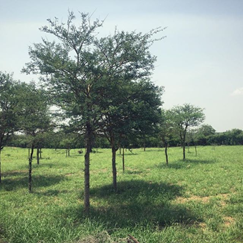- Submissions

Full Text
Approaches in Poultry, Dairy & Veterinary Sciences
Korangadu - A Unique Silvi Pasture System
Udhaya Nandhini D1*, Ajaykumar R2
1Post Doctoral Fellow, Department of Sustainable Organic Agriculture
2Senior Research Fellow, Department of Agronomy
*Corresponding author: Udhaya Nandhini, Post-Doctoral Fellow, Department of Sustainable Organic Agriculture, India
Submission: July 08, 2019;Published: September 30, 2019

ISSN: 2576-9162 Volume6 Issue4
Short Communication
Korangadu is a traditional heritage rich grazing land lying under the western agro-climatic zone of Tamil Nadu, India in the rain shadow of the Western Ghats. It exists in 500 villages over 50,000 ha. Prevailing soil type in these areas is calcareous type does not allow water stagnation regardless of the amount of rainfall. It is recognized by Globally Important Agricultural Heritage System (GIAHS) as one of the agriculture heritage site. Erratic annual rainfall compels the rural population to solely depend on livestock for their livelihood sustenance. A literal translation of the term Korangadu from the local Tamil language is “left out uncultivated land that allows natural vegetation”.
Structure of Korangadu
Korangadu has predominantly 3 major species of flora (grass, legume and tree species) which are spatially in 3 tiers. The lower tier is grown with African foxtail grass (Cenchrus ciliaris), an upper tree species include White Bark Acacia (Acacia leucophloea) and land is fenced with thorny shrub called as Indian bdellium-tree (Commiphora berryii) as live fence makes up the middle tire. Farmers used to construct a water trough in the individual plots for providing drinking water for the animals. Farmers are keeping indigenous local cattle (Kangeyam), local buffaloes and native breeds of sheep (“Mayilambadi and Meicherry” breed) in the system. Korangadu is maintained naturally without using any chemicals and can be regarded as natural farming system which uses only dung of the animal left in the field while grazing. Most of the soils are calcareous in nature and have Kankar nodules in subsurface horizons, which contributes a continuous supply of calcium required for building up of strong and sturdy cattle breeds.
Korangadu is fenced with a live hedge and a small bamboo gate through which the animals enter. Animals grown under this system are having higher growth grate with good health resulted in high milk yield and good meat quality than the stall fed system (Table 1).
The korangau is ploughed once in 2-3 years in order to break the clod and to enhance the soil aeration and moisture conservation. Hardy legumes like Mudgaparni (Phaseolus trilobus), Horse gram (Dolichos biflorus) are sown in order to enrich the nutritional status of the grassland. If the stand of grass is poor due to continuous drought over 2-3 years, then resowing of Kolukattai grass seeds is practised by the farmers Figure 1.
Table 1:

Figure 1:Animals can graze the pastures for four months in a year.

© 2019 Udhaya Nandhini D. This is an open access article distributed under the terms of the Creative Commons Attribution License , which permits unrestricted use, distribution, and build upon your work non-commercially.
 a Creative Commons Attribution 4.0 International License. Based on a work at www.crimsonpublishers.com.
Best viewed in
a Creative Commons Attribution 4.0 International License. Based on a work at www.crimsonpublishers.com.
Best viewed in 







.jpg)






























 Editorial Board Registrations
Editorial Board Registrations Submit your Article
Submit your Article Refer a Friend
Refer a Friend Advertise With Us
Advertise With Us
.jpg)






.jpg)














.bmp)
.jpg)
.png)
.jpg)










.jpg)






.png)

.png)



.png)






